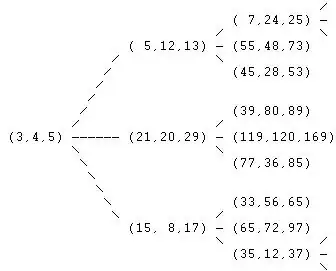It's obvious by ascent in the ternary tree of Pythagorean triples, which yields this formula:
$$\begin{align} &(x,\:\ x+1,\ z),\ \ \ X = 3x+2z+1\\[.3em]
\to\ &(X,X+1,Z),\ \ \ Z = 4x+3z+2,\end{align}\rm\ \ e.g.\quad\ $$
$\rm (3,4,5)\to (20, 21, 29)\to (119, 120, 169)\to (696, 697, 985)\to (4059, 4060, 5741)\to\cdots$
This corresponds to always taking the middle branch in the tree, see below
$\qquad\qquad$ 
The reflection that yields the descent in the triples tree is the following
$\quad\quad (x,y,z)\; \mapsto (x,y,z) - 2\, \dfrac{(x,y,z)\cdot(1,1,1)}{(1,1,1)\cdot(1,1,1)} (1,1,1)$
$\quad\quad\quad\quad\quad\quad = (x,y,z) - 2 \, (x+y-z) \; (1,1,1)$
$\quad\quad\quad\quad\quad\quad = (-x-2y+2z, \; -2x-y+2z, \; -2x-2y+3z)$
We ascend the tree by inverting this reflection, combined with trivial sign-changing reflections:
$\quad\quad (-3,+4,5) \mapsto (-3,+4,5) - 2 \; (-3+4-5) \; (1,1,1) = ( 5,12,13)$
$\quad\quad (-3,-4,5) \mapsto (-3,-4,5) - 2 \; (-3-4-5) \; (1,1,1) = (21,20,29)$
$\quad\quad (+3,-4,5) \mapsto (+3,-4,5) - 2 \; (+3-4-5) \; (1,1,1) = (15,8,17)$
Continuing in this way enables one to reflectively generate the entire tree of primitive Pythagorean triples. This has a beautiful geometric interpretation in terms of reflections - follow the first link above (which leads to the beautiful theory of reflective lattices, i.e. arithmetic groups of isometries generated by reflections in hyperplanes), and see here for sums of four squares.
